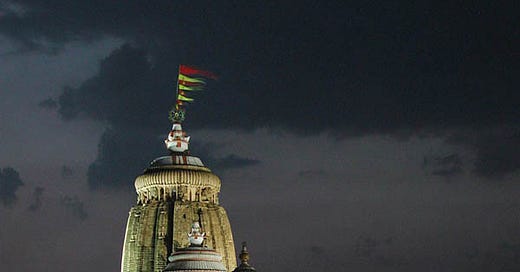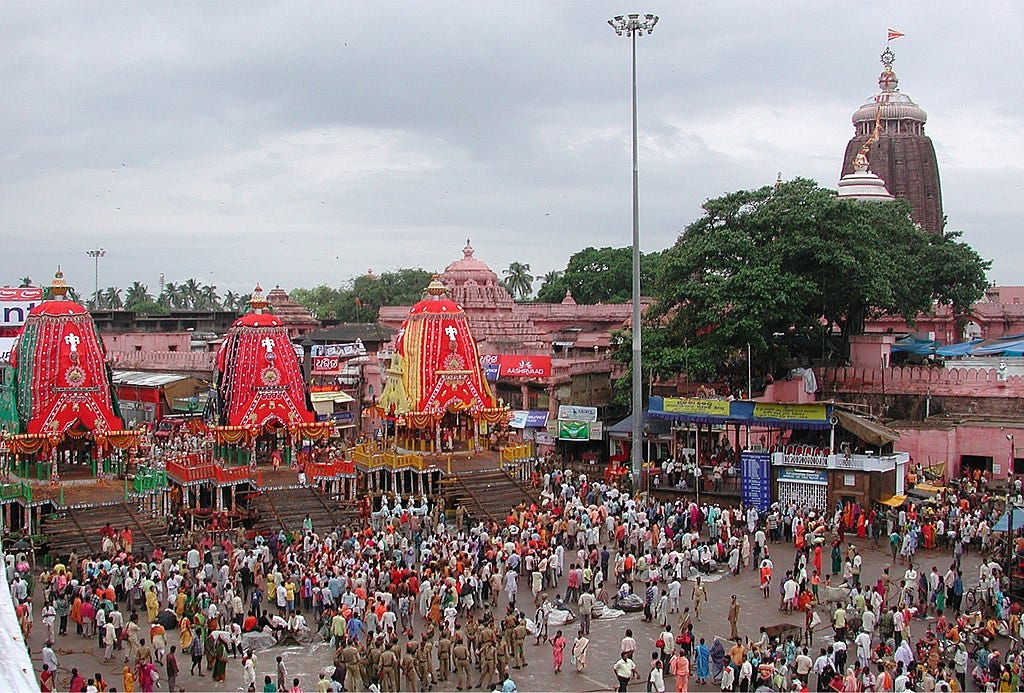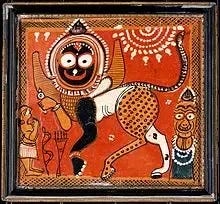Puri, one of the holiest lands also known as Shrikshetra, Purushottamapuri, Shankakshetra, and Neelachala, is a land blessed by sages such as Bhrigu, Atri, and Markandeya. The current name is a shortened version of Jagannatha Puri.
Puri is also one of the four mathas established by Adi Shankaracharya – the others being at Dwaraka, Badrinath, and Sringeri – so it occupies quite an exalted position in Indian tradition. Apart from the Govardhana Matha established by Adi Shankaracharya, Puri is also the site of many other Mathas. Chaitanya Mahaprabhu, the great Vaishnava acharya who spent his final days in Puri, and is believed to have merged with Mahaprabhu Jagannatha here, established the Radhakantha Matha here. While another great Vaishnava acharya, Ramanujacharya visited Puri during the 12th century and established the Emaar Matha here.
As one enters Puri, one can see the looming shikhara of the Jagannatha Mandir, located along the Bara Danda or the main road, the only large road in the town, on which the Ratha Yatra takes place. Many places in India have been associated with some major festival, which while celebrated in every part of the country, stand out due to the sheer scale of celebrations in that city. Ganesh Puja in Mumbai and Pune, Durga Puja of Kolkata, the Navratri celebrations of Ahmedabad, Dussehra festivities in Mysore, Ram Leela celebrations in Delhi, and of course the Ratha Yatra of Puri.
While Ratha Yatra is celebrated all over Orissa and Shree Jagannatha is one of the most revered deities there, it’s the Puri Ratha Yatra that is the most famous as it’s the abode of Mahaprabhu himself. As per the Sthala Purana, Jagannatha, literally meaning Lord of the World, was worshipped as Neela Madhab by a tribal chief. The King of Puri, Indradyumna, deputed a Brahmin priest Vidyapati to find the deities and bring them to worship in his palace. Vidyapati was taken to the cave blindfolded but he managed to mark the path with mustard seeds, which later became plants.
The King along with Vidyapati went to the cave but was unable to find the deity. Later the king had a dream, in which Jagannatha instructed the king to make murtis out of the tree near the seashore. The king likewise instructed the celestial architect, Vishwakarma, to carve the murtis, to which Vishwakarma agreed, subject to the condition that at no stage in his work would he be disturbed by anyone else. However, Indradyumna’s queen broke the rule out of curiosity and Vishwakarma disappeared leaving the murtis unfinished, which also explains their rather peculiar design.
The temple is built in the typical Oriya architecture style by Raja Ananta Barma Chodaganga Dev during the 12th century A.D. and is one of the tallest structures in India, measuring a height of 214 feet from ground level. The temple is flanked by four gates known as Simha Dwara, Ashwa Dwara, Gaja Dwara, and Vyaghra Dwara. The entry is from the Simha Dwara which is on the eastern side of the temple wall, making up the outer enclosure called the Meghanad Prachir. The temple of Jagannatha was raided by invaders eighteen times and every time, the rulers put up a defiant resistance, protecting the deities Jagannatha, Balabhadra, and Subhadra from destruction, as they were always shifted to safe locations.
After the outer enclosure, there is the inner enclosure called the Kurma Bedha, which contains the sanctum sanctorum or the Vimana. This is where the Ratna Vedi is located where you get the darshan of Jagannatha along with His brother Balabhadra and His sister Subhadra. These are the three deities taken out during the Ratha Yatra, during the month of Ashada as per the Hindu calendar.
]The innermost enclosure also covers the Jagamohan or the Audience Hall where the audience is seated during the various festivals, the Natamandapa, or the Dancing Hall where dances used to be held in ancient times, and Bhoga Mandapa, or the Hall of Offerings. If one takes a closer look at the main shikhara, one can see the Nila Chakra mounted on top, and a different flag, known as Patita Pavana, is hoisted every day.
The disc itself has eight Navagunjaras carved on it, all facing the flag post, a mythical beast, prominent in Oriya folklore and culture – called so, as it is believed to be made up of nine different animals, and is regarded as another avatar of Bhagwan Vishnu, popularized by Oriya poet Sarala Das. The Nila Chakra on top of the Shikara is distinct from the Sudarshana Chakra which is placed along with the deities in the Jagannatha Temple, and it is a very revered symbol in the Jagannatha worship, symbolizing protection.
Unlike most temples in India, where the murtis are made of iron or stone, here they are made of wood, primarily from sacred Neem logs known as Daru, which are replaced every twelve to nineteen years in a ceremony known as Nabakalebara. The belief is that Jagannatha was a tribal deity originally, which accounts for a lot of tribal traditions in His worship. The Daitapatis who perform the rituals are of tribal origin, as also many other rituals followed in the Ratha Yatra. Jagannatha, Balabhadra, and Subhadra, together are considered a manifestation of Bhairava, who is worshipped in the temple along with Bimala Devi. In a sense, it is a fusion of Vaishnava, Shakta, and Shaiva panthas, along with native tribal traditions that make up Ratha Yatra. The Jagannatha worship in Puri is symbolic of the way Hinduism is practised in Odisha, a mix of Saiva, Vaishnava, Shakta, and native tribal traditions along with Jaina and Bauddha practices, making it unique in its own way.
Singha Dwara on the Eastern side is the main entrance to the Jagannatha Temple, facing east to the Bara Danda, Puri’s main road, where the Ratha Yatra procession takes place. A flight of twenty steps called the Baisi Pachaha leads into the temple. Right in front of the Singha Dwara, there is the Aruna Stambha – a huge monolithic pillar, on the top of which there is a murti of Aruna, the charioteer of Surya. It is believed that this pillar was bought from Konark to Puri, by Maratha guru Brahmachari Gosain.
The other three entrances to the Jagannatha Temple, are the Hathi Dwara (Elephant Gate), Vyaghra Dwara (Tiger Gate), and Ashwa Dwara (Horse Gate).
Within the complex, there are temples dedicated to Bimala Devi, Mahalakshmi, Ganesha, Saraswati, and Narasimha. There is a famous story of the local Gajapati ruler Purushottama Deva, marrying the Pallava princess, Padmavati from Kanchi, and it is believed the Ucchistha Ganapati deity here was gifted by her father.
Will be covering about the Ratha Yatra in more detail, in next post.






